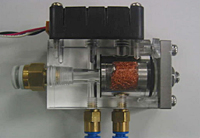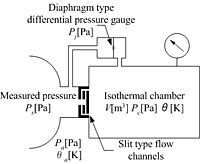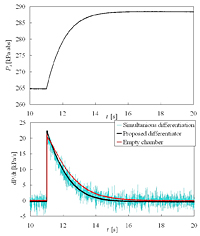The measurement of changes in pressure, or, more specifically, the differentiated value of pressure, is critical for the control of pneumatic systems such as the air-spring isolation tables used to support precision apparatus in laboratories. As the name suggests, an isolator acts as a buffer to prevent environmental vibrations, perhaps due to heavy equipment operating in the vicinity of the isolator stage, from reaching the apparatus. In the case of air-spring isolators, it is necessary to measure sudden vibrations and, via feedback circuits, adjust the position of the stage so that it remains in the required orientation.
With this aim in mind, Toshiharu Kagawa and Kenji Kawashima at the Precision and Intelligence Laboratory at Tokyo Tech have invented a novel pressure differentiator (PD sensor) for air spring-type isolation tables. The PD sensor exhibits a tenfold reduction in the noise of the output signal.
The PD sensor consists of an isothermal chamber, a slit type laminar flow element, and a diaphragm type differential pressure gauge and pressure sensor (Fig. 1). As shown in the schematic of Fig.2, changes in pressure in the sampling region cause air to flow through the narrow slit between two plates, resulting in corresponding changes in the pressure of the chamber. By measuring the differential pressure with the gauge, researchers can determine the ‘differentiated’ pressure.
Fig. 3 shows typical experimental results, where it is apparent that the Tokyo Tech PD sensor dramatically reduces the signal noise. This invention will find applications in pressure servo control systems, including air-spring isolation tables and unsteady flow generators.
The PD sensor was developed by the Kagawa and Kawashima group under the management of the Office of Industry Liaison of Tokyo Tech, with financial support from NEDO, and in collaboration with Tokyo Meter Co., Ltd. The PD sensor is now commercially available from Tokyo Meter Co., Ltd.
Reference
- 1.
- Kenji Kawashima
 et al. Development of slit-type pressure differentiator using an isothermal chamber. Meas. Sci. Tech. 16 1150–1156 (2005).
et al. Development of slit-type pressure differentiator using an isothermal chamber. Meas. Sci. Tech. 16 1150–1156 (2005).
DOI: 10.1088/0957-0233/16/5/015
Further information

Photograph of PD sensor. The length of the sensor is 45mm and the volume of the isothermal chamber filled with copper wire is 5×l0-4 m3.

Schematic of PD sensor. When the measured pressure changes, air flows through the narrow slit channel, resulting in a slight change of the pressure in the isothermal chamber. The channel was designed to maintain laminar flow.

Experimental results. The pressure change during air flow into the chamber was measured (upper figure). The PD sensor was demostrated to be more effective compared with the differentiated pressure determined from the simultaneous differentiation of the measured pressure (lower figure).
. Any information published on this site will be valid in relation to Science Tokyo.





